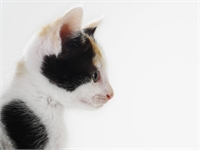
Feline Lower Urinary Tract Disease (FLUTD)
Important Notice: Our web hosting provider recently started charging us for additional visits, which was unexpected. In response, we're seeking donations. Depending on the situation, we may explore different monetization options for our Community and Expert Contributors. It's crucial to provide more returns for their expertise and offer more Expert Validated Answers or AI Validated Answers. Learn more about our hosting issue here.

Feline Lower Urinary Tract Disease (FLUTD)
You must be logged in to post a comment.
Feline Lower Urinary Tract Disease (FLUTD), formerly known as Feline Urological Syndrome (FUS), is a medical condition that affects both male and female cats. There are a variety of causes and symptoms and your cat may experience only a few or all of them. This condition can cause a complete blockage in males, which is a serious medical emergency. Without treatment, a blockage will result in death.
Urinary issues in cats are quite common. There are many reasons a cat will stop using the litterbox. The cause could be behavioral, but it’s important to rule out any underlying medical conditions before assuming it’s simply a behavior problem. There are several symptoms to look out for.
A male cat can develop debris (stones or crystals) in the bladder that can then travel down into the urethra and cause a blockage. The males narrow opening into the bladder makes him much more susceptible to a complete blockage. When a male cat is unable to urinate, the bladder becomes enlarged, very painful and could rupture. Without immediate medical treatment to unblock the urethra, the kidneys may be damaged beyond repair, the cat will suffer from uremic poisoning, coma and subsequently, death.
Females have a wider opening into the bladder and are less likely to block completely. They can still develop an infection or bladder stones requiring antibiotics and surgical treatment.
If your cat is making frequent trips to the litterbox, urinating small amounts with blood or is unable to urinate at all, a trip to the veterinarian is in order. Do not delay if a male cat is unable to urinate! If you have multiple cats in your household, it may be difficult for you to tell if one of them stops urinating. If you have a male cat that is licking his penis, howling, depressed and/or vomiting, take him to the veterinarian as soon as possible. A catheter will need to be passed into the penis to expel the urine and relieve the pressure of the overdistended urinary bladder. He will then be kept in the hospital on IV fluids to flush out his kidneys and rehydrate him.
Once a male cat has been "blocked", chances are good that it will happen again. Your veterinarian will recommend a special prescription urinary diet to help dissolve crystals and prevent stones from forming in his bladder. Feeding him the same diet as before will only result in a recurrance of the issue. Why do certain cat foods cause FLUTD in some cats? High levels of magnesium in foods are the cause. Fish-flavored diets seem to be worse for cats with urinary issues. Your veterinarian may also recommend feeding wet food for the extra moisture content.
It’s important to follow your vet’s recommendations in treating this condition. It will save you a lot of money and heartache in the future!